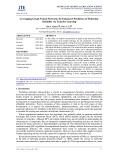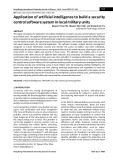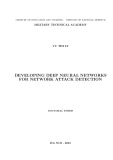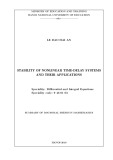
ISSN: 2615-9740
JOURNAL OF TECHNICAL EDUCATION SCIENCE
Ho Chi Minh City University of Technology and Education
Website: https://jte.edu.vn
Email: jte@hcmute.edu.vn
JTE, Volume 20, Issue 01, 02/2025
12
XNOR-Popcount, an Alternative Solution to the Accumulation Multiplication
Method for Approximate Computations, to Improve Latency and Power
Efficiency
Van-Khoa Pham1* , Lai Le2, Thanh-Kieu Tran Thi1
1Ho Chi Minh City University of Technology and Education, Vietnam
2Renesas Design Vietnam
*Corresponding author. Email: khoapv@hcmute.edu.vn
ARTICLE INFO
ABSTRACT
Received:
10/03/2024
Convolutional operations on neural networks are computationally intensive
tasks that require significant processing time due to their reliance on
calculations from multiplication circuits. In binarized neural networks,
XNOR-popcount is a hardware solution designed to replace the conventional
multiplied accumulator (MAC) method, which uses complex multipliers.
XNOR-popcount helps optimize design area, reduce power consumption, and
increase processing speed. This study implements and evaluates the
performance of the XNOR-popcount design at the transistor-level on the
Cadence circuit design software using 90nm CMOS technology. Based on
the simulation results, for the same computational function, if MAC operation
uses XNOR-popcount, the power consumption, processing time, and design
complexity can be maximally reduced by up to 69%, 50%, and 48%
respectively when compared to the method using conventional multipliers.
Thus, the XNOR-popcount design is a useful method to apply to edge-
computing platforms with minimalist hardware design, small memory space,
and limited power supply.
Revised:
15/04/2024
Accepted:
15/04/2024
Published:
28/02/2025
KEYWORDS
Multiply–accumulate operation;
XNOR-popcount;
Adder;
Latency;
Power consumption.
Doi: https://doi.org/10.54644/jte.2025.1537
Copyright © JTE. This is an open access article distributed under the terms and conditions of the Creative Commons Attribution-NonCommercial 4.0
International License which permits unrestricted use, distribution, and reproduction in any medium for non-commercial purpose, provided the original work is
properly cited.
1. Introduction
In convolutional neural networks, the convolution operation with Multiply–Accumulate (MAC)
requires complex computational hardware and high power consumption [1], [2]. The image pixels of
the receptive field are multiplied with the kernel (training weights). This multiplication is repeated until
the last pixel in the image, shifted by one pixel at a time [3]. As illustrated in Figure 1, assumed that the
convolution operation processes an input image of size 19×19 with the receptive field and the kernel
size of 4×4. To obtain a 16×16 feature map, 4096 times of multiplication, addition, and memory access
are needed. If floating-point numbers represent each value in the image pixels of the receptive field, the
convolution processing consumes a large amount of time and power due to the computation of
multiplication on floating-point data and frequent data movement between memory and processor [4],
[5]. Thus, if the data movement between memory and processor can be limited and the multiplication
with complex hardware is replaced by an approximate calculation method, the computational processing
performance will significantly increase [1], [6]. The Binary Neural Network (BNN) model uses binary
values to represent training weights and input values to reduce the network model size while still
achieving acceptable accuracy [7]-[9]. This helps save memory space and energy, and makes the model
easily deployable on edge-computing platforms with limited power and hardware resources. This study
analyzes the operation of the convolution on the BNN using the conventional multiplication and an
approximate computation method. The operation of the two designs will be executed and analyzed using
the 90nm CMOS microchip technology.

























